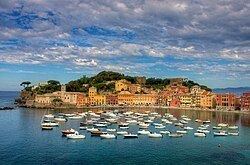Country Italy Demonym(s) Sestrini Postal code 16039 | Elevation 1 m (3 ft) Local time Thursday 12:43 PM | |
 | ||
Frazioni Azaro, Balicca Ponterotto, Cascine, Fossa Lupara, Ginestra, Libiola, Loto, Montedomenico, Riva Trigoso, Rovereto, San Quillico, San Bartolomeo, San Bernardo, Santa Margherita di Fossa Lupara, Santa Vittoria di Libiola, Tassani, Trigoso, Vignolo, Villa Arpe, Villa Campomoneto, Villa Carmelo, Villa Costa, Villa Costarossa, Villa Fontane, Villa Manierta, Villa Rocca, Villa Rocche, Villa San Bernardino, Villa Scorza, Villa Staffora, Villa Zarello Weather 18°C, Wind S at 10 km/h, 52% Humidity Points of interest Baia del Silenzio, Galleria Rizzi, Riva di Levante, Riva di Ponente | ||
Sestri Levante (Latin: Segesta Tigullorum/Segesta Tigulliorum) is a town and comune in Liguria, Italy. Lying on the Mediterranean Sea, it is approximately 56 kilometres (35 mi) south of Genoa and is set on a promontory. While nearby Portofino and the Cinque Terre are probably the best-known tourist destinations on the Italian Riviera, Sestri Levante is becoming quite a favorite among Italians. This once quiet fishing village is slowly turning into a tourist hotspot, developing an old and a new town.
Contents
Map of 16039 Sestri Levante, Genoa, Italy
Geography
Sestri Levante is found approximately halfway between Genoa and La Spezia. The town has two bays: Baia delle Favole, (Bay of the Fables), and Baia del Silenzio, the (Bay of Silence). The original part of Sestri Levante is actually on a peninsula, with the Baia del Silenzio (also known as "Portobello") on one side and Baia delle Favole on the other. Baia delle Favole or “Bay of Fairy Tales” was named in honor of Danish writer, Hans Christian Andersen, who lived in Sestri Levante for a short time in 1833.
History
Sestri Levante has its origins as an ancient maritime and merchant center. Originally a small island with a promontory, it was later connected to the mainland. In Roman times, it was known as Segesta Tigullorum (or Tigulliorum) or simply Segesta. It was mentioned in the year 909 in a certificate of a man named Berengario, in which part of its territory was ceded to the basilica di San Giovanni di Pavia; after it was invaded by the Barbarians. During the Middle Ages, Sestri Levante began to expand, probably giving the fortress appearance that is due to the terrain.
In 1133, the noble family of Lavagna, the Fieschi, attacked Tigullio, the gulf in which Sestri Levante is located, however, they were fought off by the powerful Republic of Genoa, and therefore, Sestri Levante became a part of the republic, for military protection. In the year 1145, the abbey of San Colombano was acquired by the Genoese, and was transformed later into a castle.
In 1170, Sestri Levante was attacked by a naval flotilla from Pisa, but was able to withstand the attack.
Sestri Levante is mentioned by Dante Alighieri (as "Siestri") in Canto 19 of The Divine Comedy.
Sestri Levante is also a song by Australian band Tame Impala, and appeared on their album Live Versions.
Sister cities
The frazione of Riva Trigoso is twinned with:
